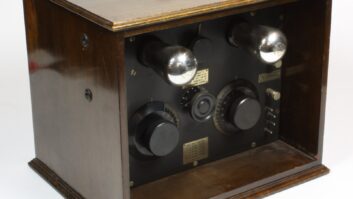Locked Up
Jan 1, 2009 12:00 PM, By Rolin Lintag, CSTE
Padlocks and gates no longer deter a thief. Either thieves are getting bolder (maybe desperate) or we have not yet done our job, or both. You can’t help but think there must be something else we can do to secure our remote sites. Although there have been numerous articles written on this subject over the years, a systematic approach can offer a different perspective.

A cover around a padlock makes it harder for a thief to cut it.
To understand the anatomy of a theft we can use an event-driven process chain. The objective of using an EPC for this discussion is to determine the step-by-step process of how a theft occurs so we can analyze where prevention or intervention can be applied. Hopefully the perpetrator can be stopped prior to any physical damage being done on the property. The cost of lost airtime, replacement and repair is primarily what we are trying to avoid. Catching a thief and bringing him to justice is just a secondary concern.
As the EPC is discussed, strategies to stop the progress of each stage are suggested. Some courses of action are recommended but it is easier to see now that you can add your own to the list. The major objective in this analysis is to deter the process as early as possible.
The survey
The perpetrator starts by surveying the property he hopes to hit. This stage may take from a simple drive by or multiple visits. Chances are he’ll hit the same day he visits. One thing is for sure, he is looking for information that will help him decide to break-in or not. Unless he is a professional and knows you are keeping gold bullions in your remote site, he’ll definitely look for an easier target if your facility looks like Fort Knox. However, if your site is like a candy store where all those goodies are in plain view, even kids will dare to break in.
Your main strategy at this stage is to give the impression that your facility is Fort Knox. Warning signs, surveillance cameras and public address (PA) systems will give loitering persons the awareness that they are being observed and will be considered as unwelcome guests in such a remote facility. Only the kamikaze-at-heart or the dumber-than-dumb will proceed beyond this point.

Communication with would-be thieves could stop them in their tracks.
Let us say he decides to break in. His first job is to make an entry, preferably with his vehicle inside the property. His motto is �Get in, take with and get out!� Anything that can delay or stop him in the process can be a reason for him to give up the ploy.
One strategy is to render useless the tools that he brought with him for the job. Design the locking of the gate in such a way that a hammer, a bolt-cutter or a torch can not help him break in. Another concern is early detection and photo identification while the attempt is at its early stage. This is the best time for police officers to arrive at the scene.
Prospecting
The perp goes around the facility looking for valuable loot he can turn into merchandise. Copper can be a primary target due to its high resale value lately. This is information that the perp already knows so all he needs to do is look for the shiny yellow metal.
One strategy to foil this stage is to hide copper and/or make its re-sale value very low by putting tar on it. Tar may work for copper used as ground wire, on guy wires or any other places not on the ground where you can tread on them. You can cover copper straps on the ground with cement. Another possible action is to glue all copper straps with F26 to the cement floor. After curing, F26 bonds the copper strap so strongly on the floor that it will take a long time even with a pry bar to jolt out the copper. For someone in haste, this can be quite a feat to overcome.
Locked Up
Jan 1, 2009 12:00 PM, By Rolin Lintag, CSTE
The take-out
You don’t want the perp to get to this stage. This is where actual damage to your transmission system can be done and possibly cause off-air time if some live electrical wires are pulled out. Depending on how much time the perp has wasted on the preceding stages, police officers should have arrived at this time. Early detection and a prompt 911 call can make a big difference in preventing damage to your facility.

Deter thieves by letting them know they’re being watched.
The thief at this point may use tools to un-screw equipment from a rack or dismantle some copper from the ground. The use of Torx screws or other means that require special tools from dismounting equipment from a rack should be used. Keys to other rooms should be hidden. Tools should be in a tool box that will be difficult to lift (if bonded to the wall or floor) or un-lock.
Surveillance cameras at strategic places can help ID the thief for use later on in the prosecution. A motion activated alarm can still stop a thief at this point. It is better to have a PA system for the Master Control operator to talk him out of the job. The psychological pressure of being in haste, plus the knowledge of being observed, and talked to at the same time can still stop a thief from doing damage to the facility. The thief may have nerves of steel but the annoyance of the ear-piercing alarm may cause him to hurt himself in pulling out the loot or just abandon the job in disgust.
The haul
This is where the thief hauls his loot onto his escape vehicle. He would want to do this as fast as he can so this stage may last only a few minutes.
One strategy you can use is to delay the hauling of loot to give police officers more time to get to the site. If police officers catch them in the act of hauling copper, the thieves are easier to prosecute. If you have road blocks or other means to prevent their escape vehicles from getting close to where the loot is, it makes it harder to do the hauling.
Once the thief or thieves get onto the vehicle with the loot, it becomes harder to apprehend them since it may require a dangerous chase if police officers arrive at this point. You don’t want anyone to get hurt particularly if the chase gets into the highway, possibly involving other motorists or pedestrians. All that trouble for some piece of scrap metal? It is better to get them at the next stage.
Marketing is where a thief turns into a businessman under whatever guise will get him through the deal. He may sell within the state where he stole the loot or he is already working with a junk shop under a previous arrangement. This is a stage in the process where partnership with local authorities is the only way to deal with the crime.
Working with local authorities, including lawmakers makes it harder for scrap metal shops to participate in transactions involving copper that may be stolen. You need to make previous arrangements with scrap metal shops with regards to their buying of copper metal that look like transmission line parts. These shops should be required to take photo IDs of sellers, inform the police and pay only with checks as preventive measures.
No one wants to be a victim of a theft that may cause the station thousands of dollars in replacement costs. This analysis should provide action steps that will suit your organization’s loss prevention objectives and thereby secure your site.
Lintag is an RF engineer for Victory TV Network, Little Rock, AR.












